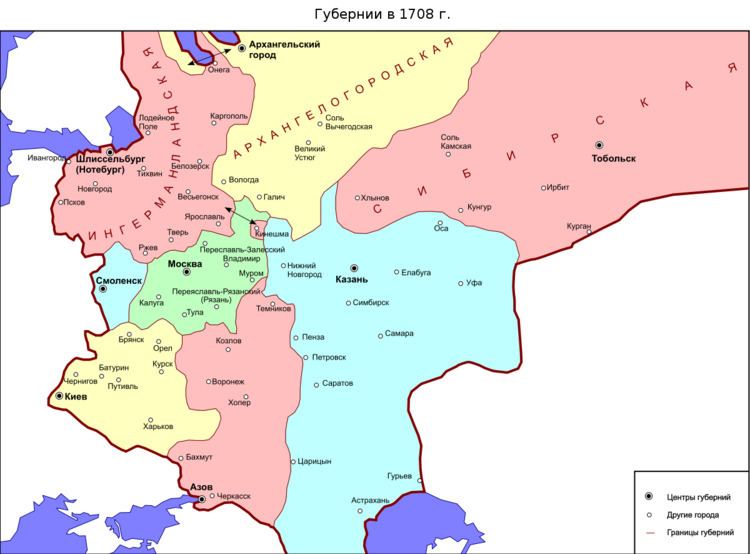1708–1725 → Disestablished 1725 | Established 1708 Capital Voronezh | |
 | ||
Azov Governorate (Russian: Азовская губерния, Azovskaya guberniya) was an administrative division (a guberniya) of the Russian Empire, which existed from 1775 until 1783. The administrative seat of the Azov Government was in the fortress of Belyov Fortress and later in Yekaterinoslav.
Contents
Geography and history
Azov Governorate was located in the northeastern Azov littoral region and covered only the southern half of the previously existing Azov Governorate of 1708-25. The new division was created from the southern Bakhmut Province of Voronezh Governorate and the self-governed frontier region of Slavo-Serbia, but primarily it was based on the recently created and quickly liquidated lands of the Don Host. Some of the lands of the Azov Governorate had been acquired by Russia from the Ottoman Empire per the terms of the Treaty of Küçük Kaynarca (signed in 1774) that were lost in 1711 due to the Pruth River Campaign in the Romanian region. In terms of the modern administrative division of Russia, the southern part of Rostov Oblast was part of the second Azov Governorate. In terms of modern Ukraine, most of East Ukraine was part of the Azov Governorate.
To the west it bordered the Novorossiysk Governorate (Kremenchug) created out of the recently liquidated Zaporizhian Sich, to the south - the Azov Sea and the Kuban region (under the suzerenity of Crimean Khanate), to the northwest - the Sloboda Ukraine Governorate (Kharkov), to the north - the Voronezh Governorate, and to the east - the Astrakhan Governorate. The Azov Governorate was also in charge of a number of fortress around the Crimean peninsula that Russia received from Ottoman Empire and the city of Kerch which controls the Strait of Kerch and access to the Black Sea.
Included territories
In 1775:
1776:
Beginning around the 1780s, the Azov Governorate was divided into counties (uyezd). The governorate was divided into two provinces, Yekaterine and Bakhmut which in turn were divided into a total of nine uyezds.
In less than ten years the government of Azov once again was liquidated after it was merged along with the Novorossiysk Governorate into the Vice-royalty of Yekaterinoslav in 1783.
List of uyezds
Administration
The Azov Government along with Novorossiysk, Astrakhan, and Saratov governments united under the Potyomkin's Novorossiysk General Government
The administration of the governorate was performed by a governor. The governors of the second Azov Governorate were
